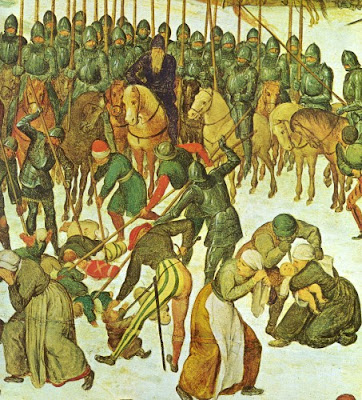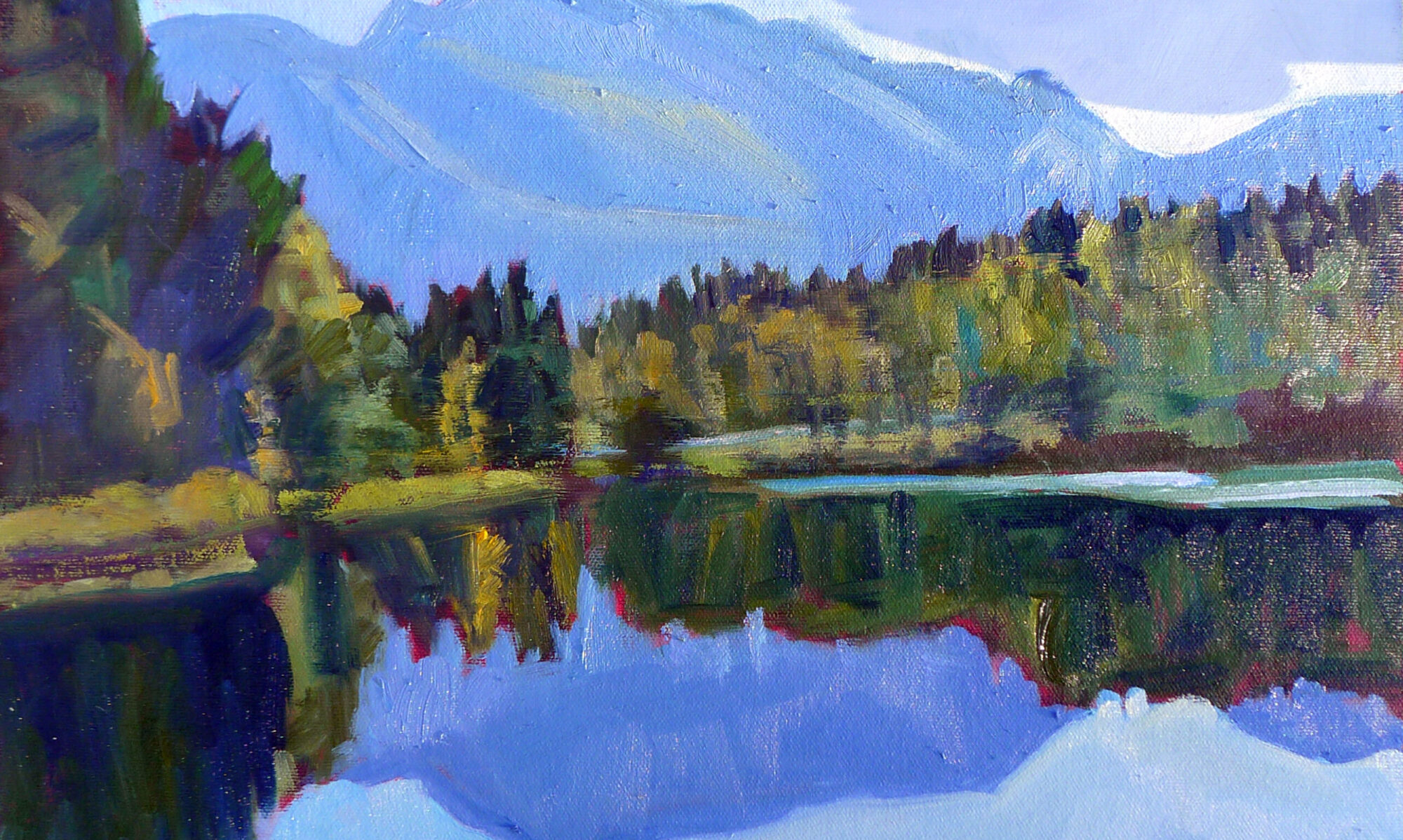Oil on wood panel, dimensions not available
Oskar Reinhart Collection, Switzerland
My students have spent a lot of time in the past two months talking about composition. They would tell you that it is passing strange to have that Nativity on the edge of the canvas, partially obscured. Many critics have noted this and concluded that this is really a just a Flemish village scene with a Nativity tossed in. I disagree.
Pieter Bruegel’s birth was unrecorded, but it is thought to have been around 1525-30 in either Liège or Brabant. Just as there is ambiguity about his birthplace, there is no record of whether Bruegel died as a Protestant or Catholic. (He was shrewd—he asked his wife to burn his papers after his death.)
Bruegel’s youthful world was wholly Catholic. His training and early career were excellent and orthodox: apprenticeship to a leading Antwerp painter in the Italianate style (Pieter Coecke van Aelst), further studies with an artist-priest (Giulio Clovio) in Rome, a now-lost church altar in 1550-51. The anomaly was Coecke’s wife, Mayken Verhulst, an artist from Mechelin. This city was an early center for peasant genre painting, and she is sometimes credited with transmitting this idea to Bruegel. (She also trained his young sons after his early death in 1569; art history knows her mainly as the root of the Brueghel painting dynasty.)
Bruegel worked with three themes throughout his career: peasants, landscape and religion. In his early work, these converged and diverged in no particular pattern. As a member of a successful atelier family (he married the Coeckes’ daughter) he flourished; he had a high degree of skill as well. But his most brilliant paintings were at the end of his life. Was that simply because he had grown to maturity, or was he responding to the trials of his times?
One of the decrees of the Council of Trent was that religious painting must be suitably elevated; saints must be set apart from mere mortals in dress, demeanor and activity. The Church recognized that saints with dirty feet were a dangerous endorsement of the Protestant concept of a priesthood of all believers.
By then, Reformation was smoldering in the Netherlands; Anabaptists and Calvinists met secretly and illegally. Bruegel left no record of what he thought of this or anything else. But from a Catholic standpoint, his paintings became positively impertinent. Of these paintings, three deserve mention. Bruegel located his Tower of Babel (1563) in a Flemish city and dressed Nimrod as a European king. The Sermon of St. John the Baptist (1566) is militant—subversive, actually—because it clearly depicts a contemporary Calvinist or Anabaptist service. In it he identifies the heretic Protestant preachers with John the Baptist. The Adoration of the Magi of 1564 is a straight-up Nativity scene, but anything but saintly. Notice Mary’s droopy veil, Joseph’s distraction, and the brutish faces of the peasants to his right.
One could ask whether these reflected the views of his patrons or his own religious convictions. I would guess that the two were so intertwined that the question is meaningless. (One of Bruegel’s most important patrons was Cardinal Antoine Perrenot de Granvelle, a leading European statesman and Counterreformer, but if Caravaggio’s experience was an indicator, we shouldn’t read too much into that.)
How powerful art can be! In 1566, the Reformation ignited in the Low Countries. It did so over the issue of art, in the form of the Beeldenstorm (“picture storm”), in which church art was systematically destroyed throughout the Netherlands. Spain responded by sending the cruel Duke of Alba to Brussels (where Bruegel had settled) to extirpate the rebels. This reign of terror—in which thousands died and many more were dislocated—led directly to the Eighty Years’ War.
It was during the height of this terror that Bruegel painted The Adoration of the Magi in the Snow. It’s lovely, but it isn’t peaceful. The central stream of figures is very nearly on the march.
The Protestant impulse forced a new way of painting. Artists couldn’t produce idols, so the pattern books of their faith—unchanged for a millennium—were closed to them. How, then, could they articulate their religious feelings? Bruegel actually painted three winter scenes of the Biblical Infancy Narratives. The others are The Slaughter of the Innocents (1565-66) and The Census at Bethlehem (1566).
 Slaughter of the Innocents, detail (1565-66)
Slaughter of the Innocents, detail (1565-66)
Pieter Bruegel the Elder
Oil on wood panel, dimensions not available
The Nativity (particularly the Virgin and Child) is the most commonly painted subject in art. Even in our secular age, even among non-Christians, it is universal. Bruegel’s brilliance was in realizing that he didn’t need to spell out the scene inside the stable; everyone knew it. In fact, in not doing so, he allowed us to regain something mysterious and personal about that night.
I must mention Bruegel’s technical prowess. Since he invented the winter landscape, he can also be credited with chromatic modeling in snow, in the form of violet shadows and the warm highlights. Note how the roof in the building on the top left is shaped by these shifts in color rather than with darker grey shadows. (This was an artistic choice; the snow on a dark winter day is generally flat.) The dark mass of people sweeps in an arc to the Nativity, pulling it back up into importance. Bruegel emphasized this sweep by making it the busiest part of his painting, and by making the figures darker and in greater contrast than the surround. This arc of humanity plays off against the perfectly composed diagonal lines of the surround.
A blessed Advent to you all.

Carol says that her students would think it strange that the nativity, perhaps the most significant event to occur on our old earth, would be relegated to the corner of a canvas.
It is no surprise to me, lover of Bruegel that I am. Immediately, two images of other Bruegel paintings resurrected themselves in my mind. Both deal with legendary events in which the main subject matter is far from the center of our attention as a viewer, and even further from the notice of the inhabitants of the painting, who, infuriatingly, continue to lumber along, subsumed into their daily routines.
The Landscape With the Fall of Icarus
http://www.abcgallery.com/B/bruegel/bruegel5.html
(you can see his leg sticking up out of the water in the lower right corner), where the foreground is taken up by a plowing farmer, a dreaming shepherd (back to the great event), and a preoccupied fisherman. The painting appears to be based on the poem by Ovid, and a great poem has been written about this painting by W. H. Auden. In it he also alludes to The Nativity which Carol has brought to our attention.
Musée des Beaux Arts
by W.H. Auden
About suffering they were never wrong,
The Old Masters: how well they understood
Its human position; how it takes place
While someone else is eating or opening a window or just walking dully along;
How, when the aged are reverently, passionately waiting
For the miraculous birth, there always must be
Children who did not specially want it to happen, skating
On a pond at the edge of the wood:
They never forgot
That even the dreadful martyrdom must run its course
Anyhow in a corner, some untidy spot
Where the dogs go on with their doggy life and the torturer’s horse
Scratches its innocent behind on a tree.
In Brueghel’s Icarus, for instance: how everything turns away
Quite leisurely from the disaster; the ploughman may
Have heard the splash, the forsaken cry,
But for him it was not an important failure; the sun shone
As it had to on the white legs disappearing into the green
Water; and the expensive delicate ship that must have seen
Something amazing, a boy falling out of the sky,
Had somewhere to get to and sailed calmly on.
The Procession to Calvary –
http://www.abcgallery.com/B/bruegel/bruegel72.html
where the figure carrying the cross is lost in the crowd (Where’s Waldo? Comes to mind – thanks, Carol!), and the eventual site of Calvary is tiny, afar off in the distance.
So at least three times, to my knowledge, Breugel offhandedly presents earth-shattering events occurring within feet or inches of the blissfully unaware populace. In the Nativity and The Procession to Calvary, they are content to go about the business of the day rather than look up and see that God Himself has shown up on the stage.
Isn’t this a more real approximation of humanity’s response to God’s presence than the typical heroic centering of the crucifixion, complete with angels and inclement weather, the typical nativity scene in all its humble, golden glory, the Baby Jesus already all-knowing?
How often does the Lord try to get our attention, yet we prefer to remain in darkness, mistaking it for the routine half-pleasures of daily existence. Fetching water, gathering twigs for the stove, warming oneself before a fire on a snowy day…somehow we have missed the Savior. Were we so sinful? Or did we just walk by him, not noticing, intent on an errand?
Toby,
Insightful stuff. Thanks for a thoughtful reply to this marvelous and message filled masterpiece.
John
Toby—I believe both our theories are true and not mutually exclusive.
The Auden is awesome, and of course you also pointed this WCW poem out me:
Landscape With The Fall of Icarus
by William Carlos Williams
According to Brueghel
when Icarus fell
it was spring
a farmer was ploughing
his field
the whole pageantry
of the year was
awake tingling
near
the edge of the sea
concerned
with itself
sweating in the sun
that melted
the wings’ wax
unsignificantly
off the coast
there was
a splash quite unnoticed
this was
Icarus drowning